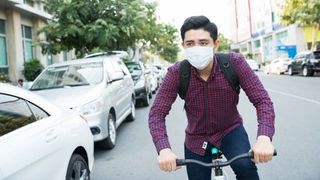Five Tips For Minimising The Risks Of London’s Air Pollution
BUPA medical director Steve Iley on how to stay safe in dirty air

Even though London’s air has improved from the era when it earned itself the moniker “The Big Smoke”, it’s still such a pressing issue that this week the European Commission issued a final warning to the capital, along with several other UK cities, over breaches to pollution limits.
Those cities now have two months to take action, although what can be done in such a short space of time is unclear. London mayor Sadiq Khan has promised to double the funding for air quality over the next five years, a measure that does little to allay the present concerns of residents, especially those who exercise outside.
A “very high” pollution alert for parts of London was issued in late January, and some areas of the capital had exceeded their annual limit for air pollution just five days into 2017.
While those in authority try to come up with a long-term solution to London’s air pollution problem, here are five tips from Steve IIey, medical director at Bupa UK Health Clinics, to help you minimise the risk to your health.
1. Keep tabs on what you’re breathing
Check the air quality so you know what to expect for the day ahead. The UK uses an air quality index and banding system which is approved by the Committee on Medical Effects of Air Pollutants.
You can see a table about the index and what the health advice is, both for those at risk and the general population, on the London Air website.
2. Stick to the back roads
Pollution in the air gets trapped in built-up areas and the concentration levels worsen. This means that busy roads and narrow streets that are surrounded by high buildings are often where pollution is highest.
Get the Coach Newsletter
Sign up for workout ideas, training advice, reviews of the latest gear and more.
Consider changing your route so that you’re walking along the back roads rather than busy, congested areas.
3. Exercise first thing
Exercise causes you to breathe harder, which means ingesting more pollutants from the air. If you exercise outside – whether you’re running, cycling or doing pull-ups on tree branches in a city park – it’s better to do so in the early morning when pollution levels are at their lowest.
4. Check the weather forecast
Still and hot weather can mean pollutants in the air hang around. This applies to more rural areas as well as busy roads. Avoid going outside in the afternoon, particularly during rush hour, when the weather is at its warmest.
5. If using a mask, get the fit right
While experts say there’s no definitive evidence that a mask will help, there are certain types of mask with submicron filter that have been shown to protect against very small airborne particles – but it’s important to make sure it fits correctly.
If you have one, check that there’s a good seal between your face and the mask so that particles don’t get through the gaps. It’s also important to follow the guidelines on replacing the filters as they do get clogged and stop working
Ordinary dust masks or scarves and bandanas won’t be effective against air pollution.
Masks can make breathing more of an effort so talk to your doctor about wearing a mask if you have a health condition that might affect this.
If you’re concerned about the effect of pollution on your body, Bupa offers health assessments that give the body a full MOT, looking at a variety of factors including heart health, fitness, weight, musculoskeletal health, blood sugar, liver function and more. Prices start at £176.

Nick Harris-Fry is a journalist who has been covering health and fitness since 2015. Nick is an avid runner, covering 70-110km a week, which gives him ample opportunity to test a wide range of running shoes and running gear. He is also the chief tester for fitness trackers and running watches, treadmills and exercise bikes, and workout headphones.
